Tanenbaum A. Computer Networks
Подождите немного. Документ загружается.

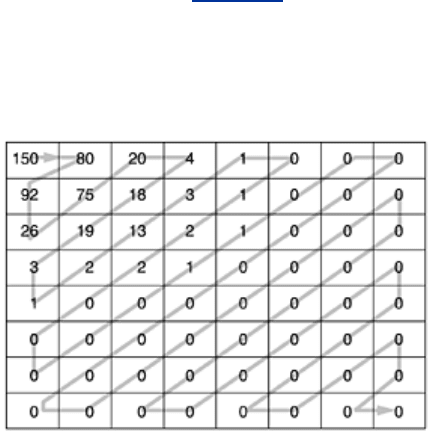
elements are the averages of their respective blocks, they should change slowly, so taking the
differential values should reduce most of them to small values. No differentials are computed
from the other values. The (0, 0) values are referred to as the DC components; the other
values are the AC components.
Step 5 linearizes the 64 elements and applies run-length encoding to the list. Scanning the
block from left to right and then top to bottom will not concentrate the zeros together, so a
zigzag scanning pattern is used, as shown in
Fig. 7-75. In this example, the zig zag pattern
produces 38 consecutive 0s at the end of the matrix. This string can be reduced to a single
count saying there are 38 zeros, a technique known as
run-length encoding.
Figure 7-75. The order in which the quantized values are transmitted.
Now we have a list of numbers that represent the image (in transform space). Step 6
Huffman-encodes the numbers for storage or transmission, assigning common numbers
shorter codes that uncommon ones.
JPEG may seem complicated, but that is because it
is complicated. Still, since it often produces
a 20:1 compression or better, it is widely used. Decoding a JPEG image requires running the
algorithm backward. JPEG is roughly symmetric: decoding takes as long as encoding. This
property is not true of all compression algorithms, as we shall now see.
The MPEG Standard
Finally, we come to the heart of the matter: the MPEG (Motion Picture Experts Group)
standards. These are the main algorithms used to compress videos and have been
international standards since 1993. Because movies contain both images and sound, MPEG can
compress both audio and video. We have already examined audio compression and still image
compression, so let us now examine video compression.
The first standard to be finalized was MPEG-1 (International Standard 11172). Its goal was to
produce video-recorder-quality output (352 x 240 for NTSC) using a bit rate of 1.2 Mbps. A
352 x 240 image with 24 bits/pixel and 25 frames/sec requires 50.7 Mbps, so getting it down
to 1.2 Mbps is not entirely trivial. A factor of 40 compression is needed. MPEG-1 can be
transmitted over twisted pair transmission lines for modest distances. MPEG-1 is also used for
storing movies on CD-ROM.
The next standard in the MPEG family was MPEG-2 (International Standard 13818), which was
originally designed for compressing broadcast-quality video into 4 to 6 Mbps, so it could fit in a
NTSC or PAL broadcast channel. Later, MPEG-2 was expanded to support higher resolutions,
including HDTV. It is very common now, as it forms the basis for DVD and digital satellite
television.
541
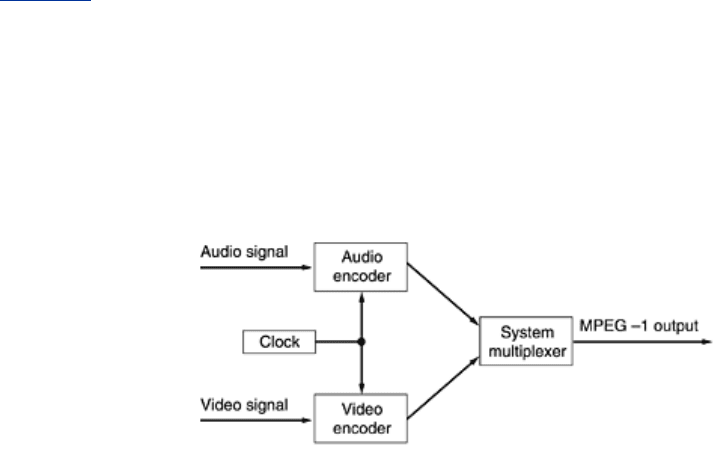
The basic principles of MPEG-1 and MPEG-2 are similar, but the details are different. To a first
approximation, MPEG-2 is a superset of MPEG-1, with additional features, frame formats, and
encoding options. We will first discuss MPEG-1, then MPEG-2.
MPEG-1 has three parts: audio, video, and system, which integrates the other two, as shown
in
Fig. 7-76. The audio and video encoders work independently, which raises the issue of how
the two streams get synchronized at the receiver. This problem is solved by having a 90-kHz
system clock that outputs the current time value to both encoders. These values are 33 bits, to
allow films to run for 24 hours without wrapping around. These timestamps are included in the
encoded output and propagated all the way to the receiver, which can use them to synchronize
the audio and video streams.
Figure 7-76. Synchronization of the audio and video streams in MPEG-
1.
Now let us consider MPEG-1 video compression. Two kinds of redundancies exist in movies:
spatial and temporal. MPEG-1 uses both. Spatial redundancy can be utilized by simply coding
each frame separately with JPEG. This approach is occasionally used, especially when random
access to each frame is needed, as in editing video productions. In this mode, a compressed
bandwidth in the 8- to 10-Mbps range is achievable.
Additional compression can be achieved by taking advantage of the fact that consecutive
frames are often almost identical. This effect is smaller than it might first appear since many
moviemakers cut between scenes every 3 or 4 seconds (time a movie and count the scenes).
Nevertheless, even a run of 75 highly similar frames offers the potential of a major reduction
over simply encoding each frame separately with JPEG.
For scenes in which the camera and background are stationary and one or two actors are
moving around slowly, nearly all the pixels will be identical from frame to frame. Here, just
subtracting each frame from the previous one and running JPEG on the difference would do
fine. However, for scenes where the camera is panning or zooming, this technique fails badly.
What is needed is some way to compensate for this motion. This is precisely what MPEG does;
it is the main difference between MPEG and JPEG.
MPEG-1 output consists of four kinds of frames:
1. I (Intracoded) frames: Self-contained JPEG-encoded still pictures.
2. P (Predictive) frames: Block-by-block difference with the last frame.
3. B (Bidirectional) frames: Differences between the last and next frame.
4. D (DC-coded) frames: Block averages used for fast forward.
I-frames are just still pictures coded using a variant of JPEG, also using full-resolution
luminance and half-resolution chrominance along each axis. It is necessary to have I-frames
appear in the output stream periodically for three reasons. First, MPEG-1 can be used for a
multicast transmission, with viewers tuning it at will. If all frames depended on their
predecessors going back to the first frame, anybody who missed the first frame could never
decode any subsequent frames. Second, if any frame were received in error, no further
542
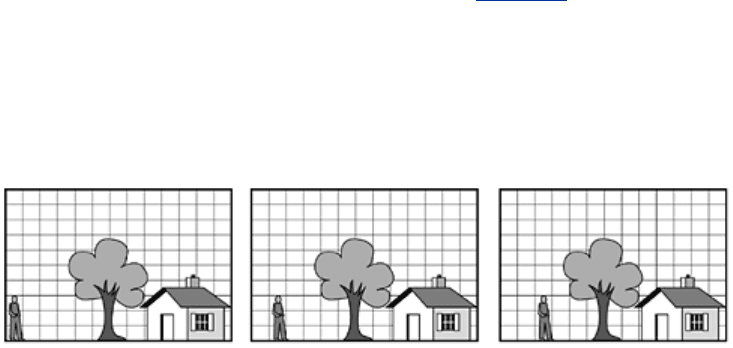
decoding would be possible. Third, without I-frames, while doing a fast forward or rewind, the
decoder would have to calculate every frame passed over so it would know the full value of the
one it stopped on. For these reasons, I-frames are inserted into the output once or twice per
second.
P-frames, in contrast, code interframe differences. They are based on the idea of
macroblocks, which cover 16 x 16 pixels in luminance space and 8 x 8 pixels in chrominance
space. A macroblock is encoded by searching the previous frame for it or something only
slightly different from it.
An example of where P-frames would be useful is given in
Fig. 7-77. Here we see three
consecutive frames that have the same background, but differ in the position of one person.
The macroblocks containing the background scene will match exactly, but the macroblocks
containing the person will be offset in position by some unknown amount and will have to be
tracked down.
Figure 7-77. Three consecutive frames.
The MPEG-1 standard does not specify how to search, how far to search, or how good a match
has to be to count. This is up to each implementation. For example, an implementation might
search for a macroblock at the current position in the previous frame, and all other positions
offset ±∆
x in the x direction and ±∆y in the y direction. For each position, the number of
matches in the luminance matrix could be computed. The position with the highest score would
be declared the winner, provided it was above some predefined threshold. Otherwise, the
macroblock would be said to be missing. Much more sophisticated algorithms are also possible,
of course.
If a macroblock is found, it is encoded by taking the difference with its value in the previous
frame (for luminance and both chrominances). These difference matrices are then subject to
the discrete cosine transformation, quantization, run-length encoding, and Huffman encoding,
just as with JPEG. The value for the macroblock in the output stream is then the motion vector
(how far the macro-block moved from its previous position in each direction), followed by the
Huffman-encoded list of numbers. If the macroblock is not located in the previous frame, the
current value is encoded with JPEG, just as in an I-frame.
Clearly, this algorithm is highly asymmetric. An implementation is free to try every plausible
position in the previous frame if it wants to, in a desperate attempt to locate every last
macroblock, no matter where it moved to. This approach will minimize the encoded MPEG-1
stream at the expense of very slow encoding. This approach might be fine for a one-time
encoding of a film library but would be terrible for real-time videoconferencing.
Similarly, each implementation is free to decide what constitutes a ''found'' macroblock. This
freedom allows implementers to compete on the quality and speed of their algorithms, but
always produce compliant MPEG-1. No matter what search algorithm is used, the final output
is either the JPEG encoding of the current macroblock or the JPEG encoding of the difference
between the current macroblock and one in the previous frame at a specified offset from the
current one.
543
So far, decoding MPEG-1 is straightforward. Decoding I-frames is the same as decoding JPEG
images. Decoding P-frames requires the decoder to buffer the previous frame and then build
up the new one in a second buffer based on fully encoded macroblocks and macroblocks
containing differences from the previous frame. The new frame is assembled macroblock by
macroblock.
B-frames are similar to P-frames, except that they allow the reference macro-block to be in
either a previous frame or in a succeeding frame. This additional freedom allows improved
motion compensation and is also useful when objects pass in front of, or behind, other objects.
To do B-frame encoding, the encoder needs to hold three decoded frames in memory at once:
the past one, the current one, and the future one. Although B-frames give the best
compression, not all implementations support them.
D-frames are only used to make it possible to display a low-resolution image when doing a
rewind or fast forward. Doing the normal MPEG-1 decoding in real time is difficult enough.
Expecting the decoder to do it when slewing through the video at ten times normal speed is
asking a bit much. Instead, the D-frames are used to produce low-resolution images. Each D-
frame entry is just the average value of one block, with no further encoding, making it easy to
display in real time. This facility is important to allow people to scan through a video at high
speed in search of a particular scene. The D-frames are generally placed just before the
corresponding I-frames so if fast forwarding is stopped, it will be possible to start viewing at
normal speed.
Having finished our treatment of MPEG-1, let us now move on to MPEG-2. MPEG-2 encoding is
fundamentally similar to MPEG-1 encoding, with I-frames, P-frames, and B-frames. D-frames
are not supported, however. Also, the discrete cosine transformation uses a 10 x 10 block
instead of a 8 x 8 block, to give 50 percent more coefficients, hence better quality. Since
MPEG-2 is targeted at broadcast television as well as DVD, it supports both progressive and
interlaced images, in contrast to MPEG-1, which supports only progressive images. Other
minor details also differ between the two standards.
Instead of supporting only one resolution level, MPEG-2 supports four: low (352 x 240), main
(720 x 480), high-1440 (1440 x 1152), and high (1920 x 1080). Low resolution is for VCRs
and backward compatibility with MPEG-1. Main is the normal one for NTSC broadcasting. The
other two are for HDTV. For high-quality output, MPEG-2 usually runs at 4–8 Mbps.
7.4.8 Video on Demand
Video on demand is sometimes compared to an electronic video rental store. The user
(customer) selects any one of a large number of available videos and takes it home to view.
Only with video on demand, the selection is made at home using the television set's remote
control, and the video starts immediately. No trip to the store is needed. Needless to say,
implementing video on demand is a wee bit more complicated than describing it. In this
section, we will give an overview of the basic ideas and their implementation.
Is video on demand really like renting a video, or is it more like picking a movie to watch from
a 500-channel cable system? The answer has important technical implications. In particular,
video rental users are used to the idea of being able to stop a video, make a quick trip to the
kitchen or bathroom, and then resume from where the video stopped. Television viewers do
not expect to put programs on pause.
If video on demand is going to compete successfully with video rental stores, it may be
necessary to allow users to stop, start, and rewind videos at will. Giving users this ability
virtually forces the video provider to transmit a separate copy to each one.
On the other hand, if video on demand is seen more as advanced television, then it may be
sufficient to have the video provider start each popular video, say, every 10 minutes, and run
544
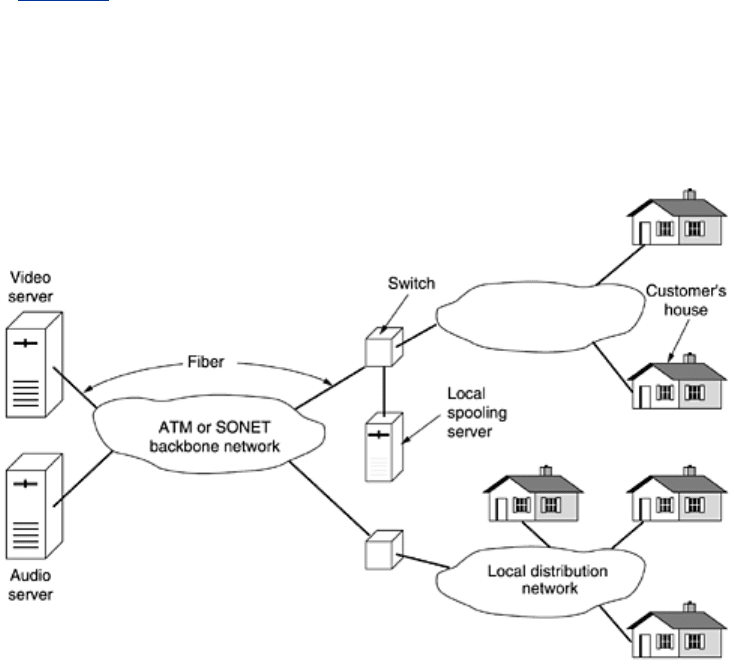
these nonstop. A user wanting to see a popular video may have to wait up to 10 minutes for it
to start. Although pause/resume is not possible here, a viewer returning to the living room
after a short break can switch to another channel showing the same video but 10 minutes
behind. Some material will be repeated, but nothing will be missed. This scheme is called
near
video on demand
. It offers the potential for much lower cost, because the same feed from
the video server can go to many users at once. The difference between video on demand and
near video on demand is similar to the difference between driving your own car and taking the
bus.
Watching movies on (near) demand is but one of a vast array of potential new services
possible once wideband networking is available. The general model that many people use is
illustrated in
Fig. 7-78. Here we see a high-bandwidth (national or international) wide area
backbone network at the center of the system. Connected to it are thousands of local
distribution networks, such as cable TV or telephone company distribution systems. The local
distribution systems reach into people's houses, where they terminate in
set-top boxes,
which are, in fact, powerful, specialized personal computers.
Figure 7-78. Overview of a video-on-demand system.
Attached to the backbone by high-bandwidth optical fibers are numerous information
providers. Some of these will offer pay-per-view video or pay-per-hear audio CDs. Others will
offer specialized services, such as home shopping (letting viewers rotate a can of soup and
zoom in on the list of ingredients or view a video clip on how to drive a gasoline-powered lawn
mower). Sports, news, reruns of ''I Love Lucy,'' WWW access, and innumerable other
possibilities will no doubt quickly become available.
Also included in the system are local spooling servers that allow videos to be placed closer to
the users (in advance), to save bandwidth during peak hours. How these pieces will fit
together and who will own what are matters of vigorous debate within the industry. Below we
will examine the design of the main pieces of the system: the video servers and the
distribution network.
Video Servers
To have (near) video on demand, we need video servers capable of storing and outputting a
large number of movies simultaneously. The total number of movies ever made is estimated at
545
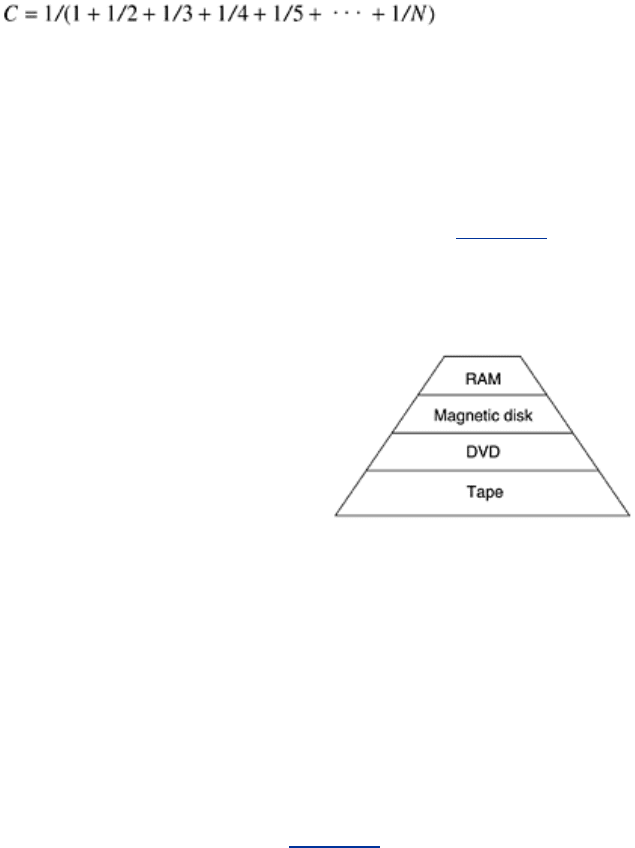
65,000 (Minoli, 1995). When compressed in MPEG-2, a normal movie occupies roughly 4 GB of
storage, so 65,000 of them would require something like 260 terabytes. Add to this all the old
television programs ever made, sports films, newsreels, talking shopping catalogs, etc., and it
is clear that we have an industrial-strength storage problem on our hands.
The cheapest way to store large volumes of information is on magnetic tape. This has always
been the case and probably always will be. An Ultrium tape can store 200 GB (50 movies) at a
cost of about $1–$2 per movie. Large mechanical tape servers that hold thousands of tapes
and have a robot arm for fetching any tape and inserting it into a tape drive are commercially
available now. The problem with these systems is the access time (especially for the 50th
movie on a tape), the transfer rate, and the limited number of tape drives (to serve
n movies
at once, the unit would need
n drives).
Fortunately, experience with video rental stores, public libraries, and other such organizations
shows that not all items are equally popular. Experimentally, when
N movies are available, the
fraction of all requests being for the
kth most popular one is approximately C/k. Here C is
computed to normalize the sum to 1, namely,
Thus, the most popular movie is seven times as popular as the number seven movie. This
result is known as
Zipf's law (Zipf, 1949).
The fact that some movies are much more popular than others suggests a possible solution in
the form of a storage hierarchy, as shown in
Fig. 7-79. Here, the performance increases as one
moves up the hierarchy.
Figure 7-79. A video server storage hierarchy.
An alternative to tape is optical storage. Current DVDs hold 4.7 GB, good for one movie, but
the next generation will hold two movies. Although seek times are slow compared to magnetic
disks (50 msec versus 5 msec), their low cost and high reliability make optical juke boxes
containing thousands of DVDs a good alternative to tape for the more heavily used movies.
Next come magnetic disks. These have short access times (5 msec), high transfer rates (320
MB/sec for SCSI 320), and substantial capacities (> 100 GB), which makes them well suited to
holding movies that are actually being transmitted (as opposed to just being stored in case
somebody ever wants them). Their main drawback is the high cost for storing movies that are
rarely accessed.
At the top of the pyramid of
Fig. 7-79 is RAM. RAM is the fastest storage medium, but also the
most expensive. When RAM prices drop to $50/GB, a 4-GB movie will occupy $200 dollars
worth of RAM, so having 100 movies in RAM will cost $20,000 for the 200 GB of memory. Still,
for a video server feeding out 100 movies, just keeping all the movies in RAM is beginning to
look feasible. And if the video server has 100 customers but they are collectively watching only
20 different movies, it begins to look not only feasible, but a good design.
546
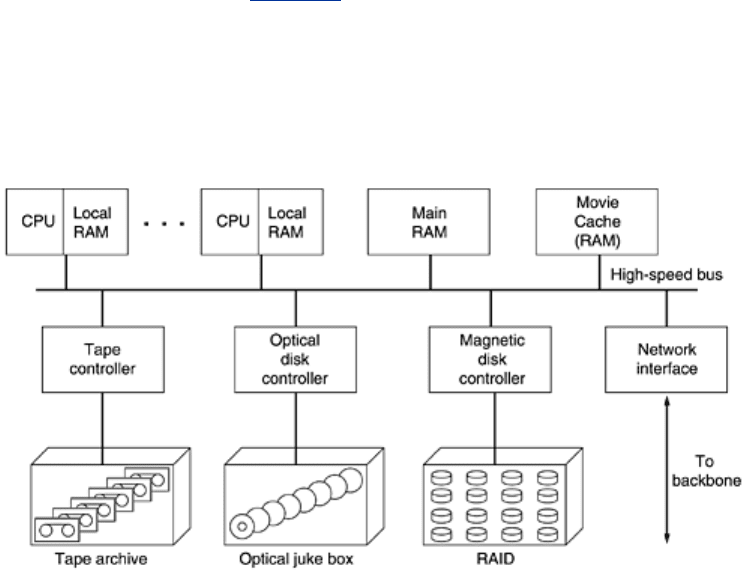
Since a video server is really just a massive real-time I/O device, it needs a different hardware
and software architecture than a PC or a UNIX workstation. The hardware architecture of a
typical video server is illustrated in
Fig. 7-80. The server has one or more high-performance
CPUs, each with some local memory, a shared main memory, a massive RAM cache for popular
movies, a variety of storage devices for holding the movies, and some networking hardware,
normally an optical interface to a SONET or ATM backbone at OC-12 or higher. These
subsystems are connected by an extremely high speed bus (at least 1 GB/sec).
Figure 7-80. The hardware architecture of a typical video server.
Now let us take a brief look at video server software. The CPUs are used for accepting user
requests, locating movies, moving data between devices, customer billing, and many other
functions. Some of these are not time critical, but many others are, so some, if not all, the
CPUs will have to run a real-time operating system, such as a real-time microkernel. These
systems normally break work up into small tasks, each with a known deadline. The scheduler
can then run an algorithm such as nearest deadline next or the rate monotonic algorithm (Liu
and Layland, 1973).
The CPU software also defines the nature of the interface that the server presents to the
clients (spooling servers and set-top boxes). Two designs are popular. The first one is a
traditional file system, in which the clients can open, read, write, and close files. Other than
the complications introduced by the storage hierarchy and real-time considerations, such a
server can have a file system modeled after that of UNIX.
The second kind of interface is based on the video recorder model. The commands to the
server request it to open, play, pause, fast forward, and rewind files. The difference with the
UNIX model is that once a
PLAY command is given, the server just keeps pumping out data at
a constant rate, with no new commands required.
The heart of the video server software is the disk management software. It has two main jobs:
placing movies on the magnetic disk when they have to be pulled up from optical or tape
storage, and handling disk requests for the many output streams. Movie placement is
important because it can greatly affect performance.
Two possible ways of organizing disk storage are the disk farm and the disk array. With the
disk farm, each drive holds some number of entire movies. For performance and reliability
reasons, each movie should be present on at least two drives, maybe more. The other storage
organization is the
disk array or RAID (Redundant Array of Inexpensive Disks), in which
each movie is spread out over multiple drives, for example, block 0 on drive 0, block 1 on
547

drive 1, and so on, with block n - 1 on drive n - 1. After that, the cycle repeats, with block n on
drive 0, and so forth. This organizing is called
striping.
A striped disk array has several advantages over a disk farm. First, all
n drives can be running
in parallel, increasing the performance by a factor of
n. Second, it can be made redundant by
adding an extra drive to each group of
n, where the redundant drive contains the block-by-
block exclusive OR of the other drives, to allow full data recovery in the event one drive fails.
Finally, the problem of load balancing is solved (manual placement is not needed to avoid
having all the popular movies on the same drive). On the other hand, the disk array
organization is more complicated than the disk farm and highly sensitive to multiple failures. It
is also ill-suited to video recorder operations such as rewinding or fast forwarding a movie.
The other job of the disk software is to service all the real-time output streams and meet their
timing constraints. Only a few years ago, this required complex disk scheduling algorithms, but
with memory prices so low now, a much simpler approach is beginning to be possible. For each
stream being served, a buffer of, say, 10 sec worth of video (5 MB) is kept in RAM. It is filled
by a disk process and emptied by a network process. With 500 MB of RAM, 100 streams can be
fed directly from RAM. Of course, the disk subsystem must have a sustained data rate of 50
MB/sec to keep the buffers full, but a RAID built from high-end SCSI disks can handle this
requirement easily.
The Distribution Network
The distribution network is the set of switches and lines between the source and destination.
As we saw in
Fig. 7-78, it consists of a backbone, connected to a local distribution network.
Usually, the backbone is switched and the local distribution network is not.
The main requirement imposed on the backbone is high bandwidth. It used to be that low jitter
was also a requirement, but with even the smallest PC now able to buffer 10 sec of high-
quality MPEG-2 video, low jitter is not a requirement anymore.
Local distribution is highly chaotic, with different companies trying out different networks in
different regions. Telephone companies, cable TV companies, and new entrants, such as power
companies, are all convinced that whoever gets there first will be the big winner.
Consequently, we are now seeing a proliferation of technologies being installed. In Japan,
some sewer companies are in the Internet business, arguing that they have the biggest pipe of
all into everyone's house (they run an optical fiber through it, but have to be very careful
about precisely where it emerges). The four main local distribution schemes for video on
demand go by the acronyms ADSL, FTTC, FTTH, and HFC. We will now explain each of these in
turn.
ADSL is the first telephone industry's entrant in the local distribution sweepstakes. We studied
ADSL in
Chap. 2 and will not repeat that material here. The idea is that virtually every house in
the United States, Europe, and Japan already has a copper twisted pair going into it (for
analog telephone service). If these wires could be used for video on demand, the telephone
companies could clean up.
The problem, of course, is that these wires cannot support even MPEG-1 over their typical 10-
km length, let alone MPEG-2. High-resolution, full-color, full motion video needs 4–8 Mbps,
depending on the quality desired. ADSL is not really fast enough except for very short local
loops.
The second telephone company design is
FTTC (Fiber To The Curb). In FTTC, the telephone
company runs optical fiber from the end office into each residential neighborhood, terminating
in a device called an
ONU (Optical Network Unit). On the order of 16 copper local loops can
terminate in an ONU. These loops are now so short that it is possible to run full-duplex T1 or
T2 over them, allowing MPEG-1 and MPEG-2 movies, respectively. In addition,
548

videoconferencing for home workers and small businesses is now possible because FTTC is
symmetric.
The third telephone company solution is to run fiber into everyone's house. It is called
FTTH
(
Fiber To The Home). In this scheme, everyone can have an OC-1, OC-3, or even higher
carrier if that is required. FTTH is very expensive and will not happen for years but clearly will
open a vast range of new possibilities when it finally happens. In
Fig. 7-63 we saw how
everybody could operate his or her own radio station. What do you think about each member
of the family operating his or her own personal television station? ADSL, FTTC, and FTTH are
all point-to-point local distribution networks, which is not surprising given how the current
telephone system is organized.
A completely different approach is
HFC (Hybrid Fiber Coax), which is the preferred solution
currently being installed by cable TV providers. It is illustrated in
Fig. 2-47(a). The story goes
something like this. The current 300- to 450-MHz coax cables are being replaced by 750-MHz
coax cables, upgrading the capacity from 50 to 75 6-MHz channels to 125 6-MHz channels.
Seventy-five of the 125 channels will be used for transmitting analog television.
The 50 new channels will each be modulated using QAM-256, which provides about 40 Mbps
per channel, giving a total of 2 Gbps of new bandwidth. The headends will be moved deeper
into the neighborhoods so that each cable runs past only 500 houses. Simple division shows
that each house can then be allocated a dedicated 4-Mbps channel, which can handle an
MPEG-2 movie.
While this sounds wonderful, it does require the cable providers to replace all the existing
cables with 750-MHz coax, install new headends, and remove all the one-way amplifiers—in
short, replace the entire cable TV system. Consequently, the amount of new infrastructure
here is comparable to what the telephone companies need for FTTC. In both cases the local
network provider has to run fiber into residential neighborhoods. Again, in both cases, the fiber
terminates at an optoelectrical converter. In FTTC, the final segment is a point-to-point local
loop using twisted pairs. In HFC, the final segment is a shared coaxial cable. Technically, these
two systems are not really as different as their respective proponents often make out.
Nevertheless, there is one real difference that is worth pointing out. HFC uses a shared
medium without switching and routing. Any information put onto the cable can be removed by
any subscriber without further ado. FTTC, which is fully switched, does not have this property.
As a result, HFC operators want video servers to send out encrypted streams so customers
who have not paid for a movie cannot see it. FTTC operators do not especially want encryption
because it adds complexity, lowers performance, and provides no additional security in their
system. From the point of view of the company running a video server, is it a good idea to
encrypt or not? A server operated by a telephone company or one of its subsidiaries or
partners might intentionally decide not to encrypt its videos, claiming efficiency as the reason
but really to cause economic losses to its HFC competitors.
For all these local distribution networks, it is possible that each neighborhood will be outfitted
with one or more spooling servers. These are, in fact, just smaller versions of the video servers
we discussed above. The big advantage of these local servers is that they move some load off
the backbone.
They can be preloaded with movies by reservation. If people tell the provider which movies
they want well in advance, they can be downloaded to the local server during off-peak hours.
This observation is likely to lead the network operators to lure away airline executives to do
their pricing. One can envision tariffs in which movies ordered 24 to 72 hours in advance for
viewing on a Tuesday or Thursday evening before 6 P.M, or after 11 P.M. get a 27 percent
discount. Movies ordered on the first Sunday of the month before 8 A.M. for viewing on a
Wednesday afternoon on a day whose date is a prime number get a 43 percent discount, and
so on.
549
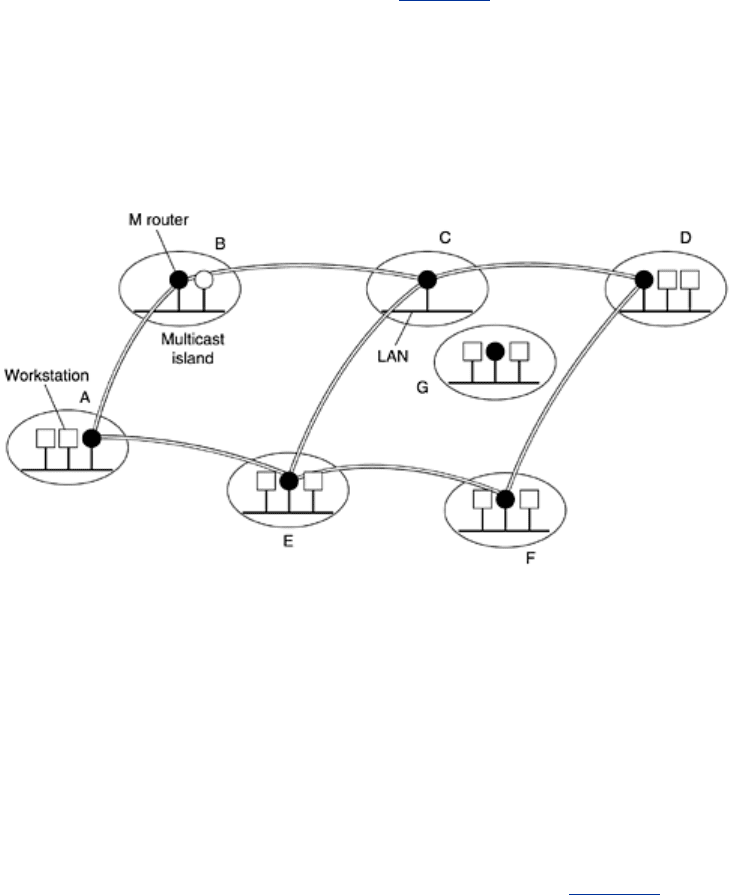
7.4.9 The MBone—The Multicast Backbone
While all these industries are making great—and highly publicized—plans for future
(inter)national digital video on demand, the Internet community has been quietly
implementing its own digital multimedia system,
MBone (Multicast Backbone). In this
section we will give a brief overview of what it is and how it works.
MBone can be thought of as Internet television. Unlike video on demand, where the emphasis
is on calling up and viewing precompressed movies stored on a server, MBone is used for
broadcasting live video in digital form all over the world via the Internet. It has been
operational since early 1992. Many scientific conferences, especially IETF meetings, have been
broadcast, as well as newsworthy scientific events, such as space shuttle launches. A Rolling
Stones concert was once broadcast over MBone as were portions of the Cannes Film Festival.
Whether this qualifies as a newsworthy scientific event is arguable.
Technically, MBone is a virtual overlay network on top of the Internet. It consists of multicast-
capable islands connected by tunnels, as shown in
Fig. 7-81. In this figure, MBone consists of
six islands,
A through F, connected by seven tunnels. Each island (typically a LAN or group of
interconnected LANs) supports hardware multicast to its hosts. The tunnels propagate MBone
packets between the islands. Some day in the future, when all the routers are capable of
handling multicast traffic directly, this superstructure will no longer be needed, but for the
moment, it does the job.
Figure 7-81. MBone consists of multicast islands connected by tunnels.
Each island contains one or more special routers called
mrouters (multicast routers). Some
of these are actually normal routers, but most are just UNIX workstations running special user-
level software (but as the root). The mrouters are logically connected by tunnels. MBone
packets are encapsulated within IP packets and sent as regular unicast packets to the
destination mrouter's IP address.
Tunnels are configured manually. Usually, a tunnel runs above a path for which a physical
connection exists, but this is not a requirement. If, by accident, the physical path underlying a
tunnel goes down, the mrouters using the tunnel will not even notice it, since the Internet will
automatically reroute all the IP traffic between them via other lines.
When a new island appears and wishes to join MBone, such as
G in Fig. 7-81, its administrator
sends a message announcing its existence to the MBone mailing list. The administrators of
nearby sites then contact him to arrange to set up tunnels. Sometimes existing tunnels are
reshuffled to take advantage of the new island to optimize the topology. After all, tunnels have
no physical existence. They are defined by tables in the mrouters and can be added, deleted,
550
